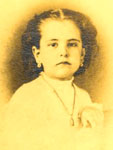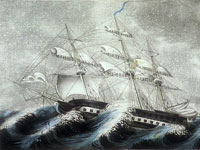1. Many idioms and words we use today arose from maritime jargon. Which of the following is not true?
b. "Blackstrap" was a sailor's nickname for tar.
"Blackstrap," today used for thick molasses, was a nickname not for tar, but for a cheap wine typically served in the Mediterranean. Sailors stationed in the area were said to be "black-strapped."
As for the other terms, cooks were permitted to keep a portion of the "slush," or fat scum from boiling meat, in the ship's stores. They then sold the fat to tallow merchants, providing the cooks with a handy "slush fund." Plates were generally square in the British Navy, for easier storage—leading to our adoption of the phrase, "a square meal." Finally, the word, "junk" originated as a word for rope worn to the point that it was useless for anything beyond making fenders or friction-reducing sail cushioning (baggywrinkle). Eventually, according to the American Heritage Dictionary of the English Language, it also was used to refer to the meat, often of poor quality, fed to sailors, and then to anything discarded or broken.
2. There are many whales in the sea, and each had its own peculiarities noted by whalers. Which of the following is not true?
a. American whalers sought out the blue whale, as its immense size provided the most blubber, and therefore, profit.
Blue whales were unmanageable with American whaling technology. (Groups with more advanced tools, such as the Scandinavians, did hunt them.)
Right whales were given their name based on their by-products and the comparative ease of the kill. Sperm whales were similarly prized; however, they often dove deeply when injured. Secured to the line of a harpoon, attendant whalers had to sever the line fast, or follow the whale to the bottom. John Smith was interested in whaling in early America. However, he failed to locate any whale species considered valuable at the time.
3. Among seafaring tales, few are as well known as Herman Melville's Moby Dick. Which of the following is not true?
c. The name of Ahab's vessel, the Pequod, is taken from a type of indigenous vessel used in Rokovoko, the island from which the character Queequeg came.
The Pequod is likely named after the Pequot, a Native American group native to what is now Connecticut. Rokovoko (or Kokovoko in some versions) is a fictional island created by Melville.
Moby Dick is thought to be based on a real white sperm whale, known as Mocha Dick. As for the chapel in New Bedford, the pulpit was added after the release of the 1956 film Moby Dick, starring Gregory Peck. The pulpit was redesigned to meet the expectations of tourists, disappointed by the lack of the prominent film feature. Finally, the Coffin and Starbuck families intermarried in the 17th century, creating a long line of Quaker whalers. Both Coffin and Starbuck remained Nantucket surnames.
4. Different groups of people were considered bad luck on ships, and treated with suspicion when on board. Which of the following groups was not considered a risk?
b. One-eyed men
There was no stigma attached to sailors or passengers with one eye—although this was not true of the cross-eyed or "swivel-eyed."
Finns were believed to whistle the winds, have the second sight, or be in league with the Devil. In contrast, preachers, as men of God, could cause harm to vessels carrying them, as the sea was considered godless. Bringing a godly individual aboard was taunting the sea. Similar superstitions, although less common, applied to the Bible. Last, but not least, women were generally considered ill luck on board. However, a naked woman would bring favor to the voyage by shaming the sea into submission. This sparked the tradition of naked female figureheads. Women were also believed to be the best navigators.
5. One final question, a "grab bag" of whaling fact and fiction. Which of the following is not true?
a. A sea shanty is a type of dance, akin to a jig, in which the watch would take turns performing.
Sea shanties were, in fact, work songs, used to time tasks that required group coordination, such as furling sails. They featured call and response singing and were highly rhythmic.
Whaling expeditions chose to freeze their vessels into the ice knowing that they would be among the first whalers in prime hunting locations come the thaw. One of the better known captains involved in the practice, George Comer, also used the winter to conduct ethnographic studies of the local Inuit. Lewis Temple, an African American man, did invent the toggle head harpoon, which released a hook on the harpoon head when it entered the whale. This prevented the harpoon from easily sliding out of the wound, and revolutionized the whaling industry. Scrimshaw was a recognized whalers' art. Common forms included pie crimpers, walking sticks, and corset busks, frequently given to sweethearts as gifts.


